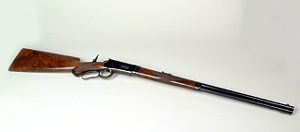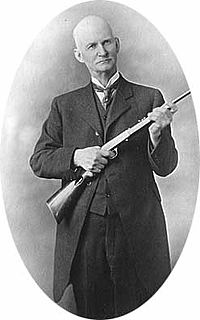John Browning
| Personal Info | |
|---|---|
| Birth | January 21/23, 1855, Ogden, Utah |
| Death | November 26, 1926, Liège |
| Aged | 71 |
| Personal Wealth | unknown |
| Company Info | |
| Name | Browning Arms Company |
| Foundation | 1927, Utah |
| Fate | 1977, acquired as a subsidiary by Fabrique Nationale de Herstal (FN) |
| Company Value | unknown |
| Headquarters | |
| Notable Weapons | |
| Pistols | M1911 pistol |
| Automatic rifles | Browning Automatic Rifle |
| Shotguns | Browning Auto-5 |
| Machine Guns | M2 Browning |
John Moses Browning (January 21[1] or January 23,[2] 1855 – November 26, 1926), born in Ogden, Utah, was an American firearms designer who developed many varieties of firearms, cartridges, and gun mechanisms, many of which are still in use around the world. He is the most important figure in the development of modern automatic and semi-automatic firearms and is credited with 128 gun patents—his first was granted October 7, 1879. He had made his first very own firearm at the age of thirteen out of a piece of scrap metal.
Browning influenced nearly all categories of firearms design. He invented or made significant improvements to single-shot rifles, lever action rifles, and slide action firearms. His most significant contributions were in the area of autoloading firearms. He developed the autoloading pistol by inventing the slide design found on nearly every modern automatic handgun. He also developed the first gas-operated machine gun, the Colt-Browning Model 1895—a system that would surpass recoil operation in popularity. Other successful designs include the M1911 pistol, the Browning .50 caliber machine gun, the Browning Automatic Rifle, and a ground-breaking semi-automatic shotgun, the Browning Auto-5.
History
Browning belonged to The Church of Jesus Christ of Latter-day Saints and served a two-year mission in Georgia beginning on March 28, 1887. His father Jonathan Browning, who was among the thousands of Mormon pioneers in the mass exodus from Nauvoo, Illinois to Utah, had established a gunsmith shop in Ogden in 1852. John Moses worked in his father's shop and later developed his first rifle, a single-shot falling-block design, in that capacity. He founded his own manufacturing operation and began to produce this firearm.
Production examples of the Browning single-shot caught the attention of the Winchester Repeating Arms Company who dispatched a representative to evaluate the competition. Winchester bought the design and moved production to their Connecticut factory. From 1883, Browning worked in partnership with Winchester and designed a series of rifles and shotguns, most notably the Winchester Model 1887 and Model 1897 shotguns, the falling block single shot Model 1885, and the lever-action Model 1886, Model 1892, Model 1894 and Model 1895 rifles, most of which are still in production today in some form; over seven million Model 1894 have been produced, more than any other centerfire sporting rifle in history.[3]
Perhaps the most infamous singular Browning-designed firearm was a FN Model 1910 handgun, serial number 19074.[4] In 1914, Gavrilo Princip used the .32 ACP pistol to assassinate Archduke Franz Ferdinand of Austria and his wife, Sophie. This event arguably sparked World War I. The pistol was rediscovered in 2004.[5]

On November 26, 1926, while working on a self-loading pistol design for FN in Liège, he died of heart failure in the office of his son Val A. Browning. The 9 mm self-loading pistol he was working on when he died was eventually completed in 1935, by Belgian designer Dieudonne Saive. Released as the Fabrique Nationale GP35, it was more popularly known as the Browning Hi-Power. The Superposed shotgun was his last firearm design, marketed originally with twin triggers. A single trigger modification was later completed by his son, Val.
Throughout his life, Browning designed weapons for his own company, Winchester, Colt, Remington, Savage, and Fabrique Nationale of Belgium. In 1977, FN acquired the Browning Arms Company which had been established in 1927, the year after Browning's death.
Products
Several of his designs are still in production today. Some of his most notable designs include:
Firearms
- M1895 Colt-Browning machine gun
- FN Browning M1899/M1900
- Colt Model 1900
- Colt Model 1902
- Colt Model 1903 Pocket Hammer (.38 ACP)
- Colt Model 1903 Pocket Hammerless (.32 ACP)
- Colt Model 1905
- Remington Model 8 (1906), a long recoil semi-automatic rifle
- Colt Model 1908 Vest Pocket (.25 ACP)
- Colt Model 1908 Pocket Hammerless (.380 ACP)
- FN Model 1910
- U.S. Model 1911 pistol
- Colt Woodsman pistol
- Winchester Model 1885 falling block single shot rifle
- Winchester Model 1886 lever-action repeating rifle
- Winchester Model 1887 lever-action repeating shotgun
- Winchester Model 1890 slide-action repeating rifle (.22)
- Winchester Model 1892 lever-action repeating rifle
- Winchester Model 1894 lever-action repeating rifle
- Winchester Model 1895 lever-action repeating rifle
- Winchester Model 1897 pump-action repeating shotgun
- Browning Auto-5 long recoil semi-automatic shotgun
- U.S. Model 1917 water-cooled machine gun
- Model 1919 air-cooled machine gun
- Browning Automatic Rifle (BAR) of 1917
- Browning M2 .50-caliber heavy machine gun of 1921
- Remington Model 8 semi-auto rifle
- Remington Model 24 semi-auto rifle (.22) Also produced by Browning Firearms (as the SA-22) and several others
- The Browning Hi-Power, the last pistol that John Browning developed
- The Browning Superposed over/under shotgun was designed by John Browning in 1922 and entered production in 1931
Cartridges
In addition, the cartridges he developed are still some of the most popular in the world. They include:
Military weapons
The Colt 1911, Browning 1917/19, and the BAR saw action with US forces in World War I, World War II and the Korean War, with the 1911 going on to serve as the U.S.'s standard military side arm until 1986; a variant is still used by special operations units of the United States Marine Corps and the design remains very popular amongst civilian shooters. The Browning Hi-Power would have a similarly lengthy period of service outside the United States, and remains the standard side arm of the Australian, British, and Canadian armed forces. The M2 Browning machine gun, which was developed in the late 1910s, remains in service with armed forces across the world in a variety of roles.
Selected patents
- U.S. patent 220,271 Winchester 1885 single-shot, Browning’s first patent
- U.S. patent 306,577 Winchester 1886 and Model 71 lever action rifles
- U.S. patent 336,287 Winchester Model 1887/1901 lever action shotgun
- U.S. patent 385,238 Winchester 1890 pump action rifle
- U.S. patent 441,390 Winchester 1893 and 1897 pump action shotguns
- U.S. patent 465,339 Winchester 1892 lever action rifle
- U.S. patent 524,702 Winchester 1894 lever action rifle
- U.S. patent 544,657 Colt-Browning Model 1895 machine gun
- U.S. patent 549,345 Winchester 1895 lever action rifle
- U.S. patent 580,924 Colt 1900 automatic pistol
- U.S. patent 632,094 Winchester 1900 bolt action single shot .22 rifle
- U.S. patent 659,507 FN/Browning Auto-5 shotgun, also Remington Model 11
- U.S. patent 659,786 Remington Model 8 semi-automatic rifle
- U.S. patent 678,937 M1917 Browning machine gun
- U.S. patent 747,585 Colt Model 1903 Pocket Hammerless automatic pistol
- U.S. patent 781,765 Stevens 520 pump action shotgun
- U.S. patent 808,003 Colt Model 1905 in .45 ACP (predecessor to the M1911)
- U.S. patent 947,478 FN Model 1906 and Colt Model 1908 Vest Pocket in .25 ACP
- U.S. patent 984,519 Colt 1911
- U.S. patent 1,065,341 Browning 22 Semi-Auto rifle and Remington model 24
- U.S. patent 1,143,170 Remington Model 17 and Ithaca 37 pump action shotguns
- U.S. patent 1,276,716 Colt Woodsman
- U.S. patent 1,293,022 Browning Automatic Rifle Model of 1918
- U.S. patent 1,424,553 FN "Trombone" pump action .22 caliber repeater (Rare in USA)
- U.S. patent 1,525,065 37 mm automatic cannons, M1 and M4
- U.S. patent 1,578,638 Browning Superposed over/under shotgun
- U.S. patent 1,618,510 FN and Browning Hi-Power pistol
- U.S. patent 1,628,226 M2 Browning machine gun in .50 caliber
See also
References
- ^ Encyclopedia Britannica online, "John Moses Browning".
- ^ Pelley, Doug (2004-07). "Pictures of Headstones: John M. Browning". Retrieved 2007-01-23.
{{cite web}}: Check date values in:|date=(help) - ^ Harold A. Murtz, ed. Gun Digest Treasury (DBI Books, 1994), p. 190.
- ^ Belfield, Richard. The Assassination Business: A History of State-Sponsored Murder, Carroll & Graf Publishers: New York. ISBN 0786713437. p. 237.
- ^ Connolly, Kate (21 June 2004). "Found: the gun that shook the world". The Daily Telegraph. Retrieved 2 April 2009.
- Browning, John, and Curt Gentry. John M. Browning, American Gunmaker. New York: Doubleday, 1964. OCLC 1329440

